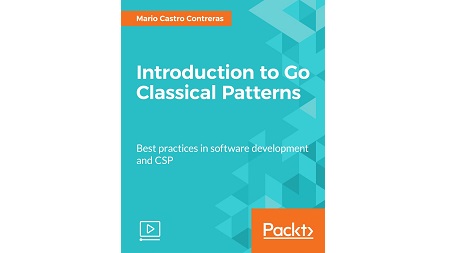English | MP4 | AVC 1920×1080 | AAC 44KHz 2ch | 3h 32m | 879 MB
Learn idiomatic, efficient, clean, and extensible Go classical design patterns by using TDD
Go is a multi-paradigm programming language that has built-in facilities to create concurrent applications. Design patterns allow developers to efficiently address common problems faced during developing applications. Go Design Patterns will provide readers with a reference point to software design patterns and CSP concurrency design patterns to help them build applications in a more idiomatic, robust, and convenient way in Go. The book starts with a brief introduction to Go programming essentials and quickly moves on to explain the idea behind the creation of design patterns and how they appeared in the 90’s as a common “language” between developers to solve common tasks in object-oriented programming languages. You will then learn how to apply the 23 Gang of Four (GoF) design patterns in Go and also learn about CSP concurrency patterns, the “killer feature” in Go that has helped Google develop software to maintain thousands of servers. With all of this the book will enable you to understand and apply design patterns in an idiomatic way that will produce concise, readable, and maintainable software.
This course will teach widely used design patterns and best practices in Go in a step-by-step manner. The code will be accompanied by detailed examples, to allow programmers to apply design patterns in their day-to-day coding.
What You Will Learn
- The basic syntax and all the tools needed to start coding in Go
- Encapsulate the creation of complex objects in an idiomatic way in Go
- Create unique instances that cannot be duplicated within a program
- Understand the importance of object encapsulation to provide clarity and maintainability
- Prepare cost-effective actions so that different parts of the program aren’t subject to expensive tasks
Table of Contents
01 The Course Overview
02 Installing Go
03 Starting with Hello World
04 Flow Control
05 Functions
06 Arrays, Slices, and Maps
07 Pointers, Structures, and Interfaces
08 Testing and TDD
09 Libraries
10 Go Tools
11 Singleton Design Pattern
12 Builder Design Pattern
13 Factory Method
14 Abstract Factory
15 Prototype Design Pattern
16 Composite Design Pattern
17 Adapter Design Pattern
18 Bridge Design Pettern
19 Proxy Design Pattern
20 Decorator Design Pattern
21 Facade Design Pattern
22 Flyweight Design Pattern
Resolve the captcha to access the links!
